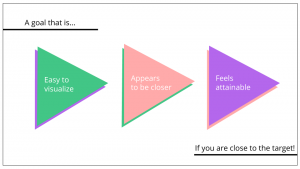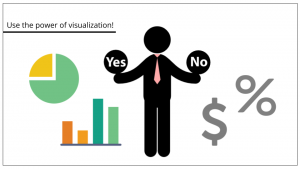I’m sure you have some idea of how visualizations can help goal pursuit. I’m also convinced that the research I am about to summarise for you, will shed a little more light on the issue.
What do Olympic swimmers, consumers waiting in line for service and sales people have in common? They can all be influenced to persist, strive and get to their goal more likely and faster if they are properly motivated with visuals. But, there’s a catch, which I will get to soon.
Visual representations influence perceptions
In a research conducted by Amar Cheema and Rajesh Bagchi, the authors find a correlation between visualizing a goal and pursuing a goal. The article “The effect of goal visualisation on goal pursuit: implications for consumers and managers” can be found in the Journal of Marketing Vol 75. (March 2011) by the American Marketing Association.
Cheema and Bagchi tell us that
“People process visual representations in a manner similar to distance, influencing perceptions of proximity and effort”
An easy to visualize goal feels more attainable
To sum up the research results: If a goal is easy to visualize, it appears to be closer, which makes it feel more attainable. This may increase…. Wait for it… optimism, motivation, commitment, engagement, effort, persistence, performance, productivity and perceived progress. Now that is a list to take seriously!
It is however important to note – this is the catch – that this “chain reaction” is only applicable if a person is already close to reaching the goal. Visualisations do not work if you are far from the goal.
Swimmers swim faster towards the finish line
The research demonstrates that in later parts of 1500-meter Olympic and sectional swimming competitions, swimmers swim faster towards the finish line than when they do swimming away from the finish line. So, faster towards a goal, which is easy to visualise, as opposed to the opposite direction where the goal is difficult to visualise.
People save more money if progress is not explained in dollars
The research shows that people save more money when they are incentivised by a visual representation of the progress as opposed to getting the same progress information explained in dollars. Again, this only works if you are near the goal.
![]() Photo by rawpixel.com on Unsplash
Photo by rawpixel.com on Unsplash
Queuing feels less painful
If you are getting closer to the service agent and can visualise it easily, you are more likely to persist and feel that you are progressing, compared to others who cannot visualise being close to the “finish line”.
Sales is done faster
Same law applies with sales people and their goals. In the case of the a sales competition, research study participants sold 20 cases faster when the goal was easy to visualise than when it was not. In contrast visualisation did not have an impact when the goal was split into four subgoals.
Subgoals might however work if the overall goal is, as the researcher say, “uncertain”, as to say that it is not a clear number. An example of such a situation would be to ask sales people to sell as much as they can as fast as they can.
 Photo by Lukas Blazek on Unsplash
Photo by Lukas Blazek on Unsplash
How you can use this in your work
Think about what it is in your business that you aim to do, or get others to do. Are goals concrete and can you monitor progress? Do you know when someone is getting close to their goal? If yes, why not help speed up reaching that goal with a visualisation?
Visual representations are easier to process and hence take less mental energy, leaving more energy to focus on the goal and reaching it. Use visual representations like pie charts and bar graphs as opposed to text, numbers or percentages. If you and your client, or you and your team, are near your goal, you can engage everyone to reach the goal by showing progress and how much is left in the form of a pie chart or bar graph.
What are the goals you are working towards on your own or with someone? Are you using the power of visualisation to help you reach that goal?


 Icons from Flaticon
Icons from Flaticon